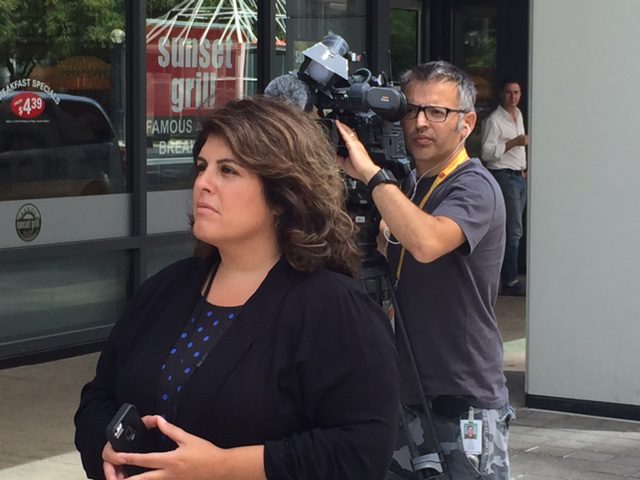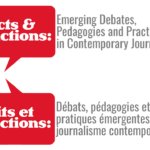Why j-school instructors should return to newsrooms for a summer
Marlene Murphy speaks with a handful of academics who choose to return to the industry after they their submit their students’ marks in May.
[[{“fid”:”4675″,”view_mode”:”default”,”fields”:{“format”:”default”,”field_file_image_alt_text[und][0][value]”:””,”field_file_image_title_text[und][0][value]”:””},”type”:”media”,”link_text”:null,”attributes”:{“height”:480,”width”:640,”style”:”width: 400px; height: 300px; margin-left: 10px; margin-right: 10px; float: right;”,”class”:”media-element file-default”}}]]By Marlene Murphy
The term’s long over and the weather’s warm. For broadcast journalism professor Marisa Dragani, it’s time to stop teaching students about covering the news, and do some reporting herself.
“I really want to be able to know my students’ reality when they graduate and start working in the industry,” said Dragani, who returned to her former job as a national reporter at CBC Television News for some shifts in Toronto over the summer.
Since leaving the CBC three years ago, Dragani has worked as a professor at Loyalist College in Belleville, Ont. “The bottom line is we want our students to get jobs,” she said. “We want them to be employable. We’re an intimate program and we can take what we see in newsrooms and bring it back and fashion our program to meet those demands.”
Dragani is one example of instructors who return to newsrooms during their months off to keep abreast of reporting trends, check out how digital tools are being used and put their skills to use in real-world settings. It’s tricky to pull off, but those who can manage the turn of seasons say it’s worth it.
One of Dragani’s colleagues at Loyalist College, Robert Washburn, is a professor in the online journalism program. He spends a few weeks each summer as a reporter at Northumberland Today, in addition to his work as a columnist for the paper. “So much changes in our industry now in a year, it just blows me away,” he said. “When you get in there and actually pick up a pen and notepad and start dialing a phone and have to deal with some of this stuff professionally it puts a different light on it, and that I find extraordinarily helpful.”
Mike Karapita does occasional shifts at the CBC in Toronto at News Network and online, as well as some training for CBC journalists. “For me personally, it’s essential that I do this,” said the journalism coordinator at Humber College in Toronto. “It enables me to really know what’s going on and what it’s like today. It allows me to have incredible credibility in the classroom.”
Karapita worked as a producer and executive producer in radio and television at the CBC until leaving for Humber a decade ago. He’s been doing casual shifts since then, and has seen big changes. “I see more integration and sharing of information on breaking news and developing news stories, which is fantastic,” said Karapita,“I see so much more use of digital technology and digital news gathering systems that just didn’t exist even ten years ago.”
Dragani said her focus would once have been on gathering and preparing a single television report for the National. She said reporters can now be tweeting as soon as they arrive at a story, doing live reports and sometimes filing to radio and online as well. “What I’m seeing is definitely the push to digital. How much more online matters in the whole scheme of things.”
Washburn said at the start of his career, he would never had done an interview by email—and would have berated students to make phone calls or get interviews in person. He’s said he’s seen changes with smaller municipalities tightening up media relations. “Now, it’s quite customary when dealing with government agencies: send us your questions and we’ll get back to you.” Washburn said it’s just one example of an insight that helps him troubleshoot with students.
All three say they’ve been able to use newsroom experiences in their academic lives.
“We do program reviews every year,” Dragani explains.”We can kind of mirror exactly what industry is doing with these student journalists.”
“I’ve worked with my fellow faculty members to dramatically reinvent our curriculum because of the kind of exposure I’ve had at cbc.ca—adding in things like using social media extensively, using all kinds of cool new digitial tools like Storify, informational graphics and data journalism,” Karapita offers.
But heading back to a newsroom may not be a practical option, for personal or professional reasons. The reality of the university tenure track, where hopefuls are evaluated on their research, can mean time away from the classroom is directed toward that work instead, especially when some schools may not give reporting or editing stints the same weight in a research file—or even consider them at all.
“I do academic work but I don’t have the same requirements as those who teach in a university, so I can really empathize, because I’ve done conference papers, I’ve written a chapter for book that’s coming out shortly,” said Washburn. He said while he’s found a way to make it all fit, it may not be for possible for others.
“I think probably I would have had more respect from some quarters if I had done research rather than the practical work in the newsroom,” acknowledges Mary Doyle, who retired from the University of Western Ontario’s Faculty of Media and Information Studies three years ago.
Doyle came to Western after 15 years of journalism jobs, including The Globe and Mail. She spent several summers working on the copy desk at The New York Times, but said school administrators didn’t always see its value. “I ran into a few problems with the university culture, where there’s emphasis on doing research, rather than what I think is a bit equivalent, which is keeping up on practical skills when you’re teaching in a professional program.”
Still, she was enthusiastic about her copy editing shifts in New York, and what it brought to her teaching. “When I would come back in September I was so on point,” she said. “There were no questions I didn’t know the answer to—I was so immersed,” she said. She said shifts there, and at the Globe and the London Free Press, also helped with making contacts for placing students.
So, what options do faculty members have to stay plugged in if a return to the newsroom isn’t a viable option? Paul Benedetti, a colleague of Doyle’s at Western, said many faculty members keep a hand in journalism by doing columns or other freelance work, and that staying current can be achieved in a number of ways. “I’ve met and spoken with a lot of editors because we do internship placements,” he explains. “I try to find out as much as possible where they’re at and what their newsroom looks, and what they want and what they think they need,” he said. “I don’t always absolutely agree, and deliver everything they say they need, but I certainly find out what it is they’re doing, how they’re running their newsroom, and that informs us.”
Benedetti said journalism programs are able to incorporate the latest ideas. ”In some cases, newsrooms are behind universities,” he said. “We’re trying to stay right on the edge, and they’re behind because they’ve got a lot more legacy issues and money issues to deal with.”
Benedetti, like the others, also emphasized the need to teach critical thinking skills to go along with the new technological practices. “Many of the fundamentals of journalism are fundamentals, and don’t really change just because the tools change,” he points out.
For now, Dragani, Washburn and Karapita have no plans to exit the newsroom entirely.
“I’m really proud of being able to do that,” Karapita said about his newsroom shifts.”It’s also really exciting – it rocks your world. It’s a different pace than academia—it’s go go go and sometimes it’s very intense but it’s very rewarding.”
“I love daily news. I love breaking news. It kinds of fulfills that craving for it,” said Dragani of her reporting stints.
Washburn is doing more work this summer with a local community radio station in addition to his newspaper work. He said he feels fortunate he can work the way he does, and is passionate about keeping a hand in. “These young people when we finish if we’ve done our jobs right have all of our skills rolled into them,” he enthuses.” I marvel sometimes at what it must be like to learn it right from ground zero as being a multimedia journalist, rather than having to be someone who has to expand their skill set or add on or learn to do these things.”
Illustration photo: Marisa Dragani, doing an interview outside the CBC Broadcast Centre in Toronto for a story on announced Ontario pension plan changes. Photo by Simon Dingley.




